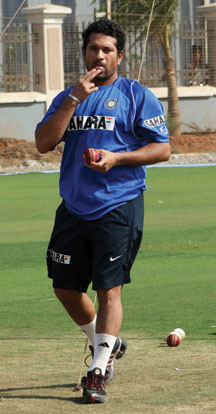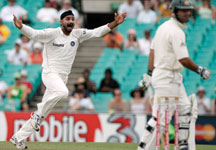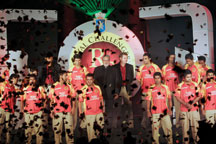Business
Moving Into A League Of Its Own
|
Corporate cricket in India has never been of a particularly high standard. At the bottom end of the leagues, companies form makeshift teams from their own ranks. Anyone who has ever wielded a bat is enlisted to play. You bat a bit, bowl a bit and then disband for beer. (The demon bowler who could mess up the proceedings by being too “professional” is given beer before the match, not after.) “Save for Mumbai teams … inter-corporate matches in India have never been very serious,” says Sandeep Bamzai, the author of Guts and Glory: The Bombay Cricket Story. Come April 18, it will be a different ballgame. Eight companies are vying for top honors in the Indian Premier League (IPL). They include Mukesh Ambani’s Reliance Industries, Vijay Mallya’s UB Group, India Cements, GMR Holdings, filmstar Shah Rukh Khan’s Red Chillies Entertainment, and some makeshift alliances such as actor Preity Zinta and Ness Wadia, joint managing director of Bombay Dyeing, a leading textile manufacturer. These companies and combines have bid for and won franchises for eight major Indian cities. The tournament, to be played over 44 days in a 20-overs-a-side (Twenty20) format, will pit these eight teams against one another.
The marketers have already swung into action. The Bangalore team – owned by Mallya – has been named Royal Challengers, after one of the liquor baron’s popular whisky brands. Khan has called his Kolkata (formerly Calcutta) team the Knight Riders, “inspired by the phrase knight in shining armor.” The Chennai team, owned by India Cements, will be known as the Super Kings. (India Cements has brands such as Coromandel King.) Others, too, are rolling out elaborate plans. They need to do that. By Indian standards, they have already paid large sums for these teams. The franchises for the eight cities were auctioned by the Board of Control for Cricket in India (BCCI). The auction took place in an extravaganza worthy of a Twenty20 match. Against a floor price of $50 million, Ambani won Mumbai with a bid of $111.9 million. Other winners included Mallya (Bangalore; $111.6 million), Hyderabad (Deccan Chronicle; $107.01 million), Chennai (India Cements; $91 million), Delhi (GMR; $84 million), Mohali (Preity Zinta and Ness Wadia; $76 million), Kolkata (Shah Rukh Khan; $75.09 million), and Jaipur (Emerging Media; $67 million). Incidentally, one of the losing bidders has offered to pay $130 million for a team if any of the franchisees is willing to sell. Going, Going… The payment for the teams was just the beginning. That auction was followed by bidding for the players. The best cricket players from all over the world were up for grabs. The top bid was for India’s Twenty20 and one-day cricket captain, Mahendra Singh Dhoni, who went to Chennai for $1.5 million. Andrew Symonds of Australia was bagged by Hyderabad for $1.35 million. Other rounds of bidding are still on. With each team needing 16 men (11 players, a 12th man and four reserves), the price tag will keep climbing. Team Hyderabad, for instance, has already paid some $6 million for 11 players and will need to fork over more for the rest. The bids would have been higher, but for the fact that some iconic players – former India captains Sachin Tendulkar, Sourav Ganguly and Rahul Dravid – weren’t available. They are captains of the cities they are associated with (Mumbai, Kolkata and Bangalore, respectively) and will be paid 15% more than the highest-paid player in their teams. These fees for players are hardly unusual by international standards. For example, Forbes magazine estimates golfer Tiger Woods’ annual income at $100 million. But for cricket – and not just in India – this is big money. Australian Ricky Ponting, the highest-paid cricketer in the highest-rated country team, takes home only $800,000 a year. Sponsorships bring this up to $4 million. These large deals are already attracting criticism. Left-wing political parties have demanded an investigation into the “sources of hundreds of crores of black money spent on the auction” and why the government has condoned such “outrageous gambling.” Not to be outdone, the right-wing Shiv Sena party has described the auction as the “gambling of industrialists.” The auctions, though, are a small part of the money machine. The BCCI had earlier sold the 10-year television rights to Sony Entertainment, the Indian subsidiary of Japan’s Sony, and World Sports Group (WSG), an Asia-focused sports marketing and management agency, for more than $1 billion. Together with the other takings, IPL is already a $2 billion business. As Lalit Modi, BCCI vice-president and chairman and match commissioner of the IPL, says: “IPL is the best thing that has happened to cricket. Corporate India is convinced about the product and the revenue model and has shown the appetite and passion for cricket.” Monetizing the Game Modi, scion of a business family that owns tobacco-maker Godfrey Phillips, is the new face of the Indian cricket establishment. He studied marketing at Duke University in North Carolina, where he learned about the major U.S. sports leagues. “We have succeeded in monetizing the game,” he says. “Yes, priorities have changed for a segment of the population,” says Sridhar Samu, professor of marketing at the Indian School of Business (ISB), Hyderabad. Adds Bamzai: “Cricket today is a metaphor for change.” According to Ashish Kaul, executive vice-president of the Indian Cricket League (ICL), a rival to IPL: “We as a country have reached a stage where entertainment is a basic necessity and not a leisure activity. Cricket is the lowest common denominator of this country and perhaps the largest entertainer.” Corporate India – in the form of the new cricket leagues – will give the fans all the change they want. The game in its Twenty20 format has metamorphosed a great deal from its traditional five-day test match version. The first innovation – the 50-over-a-side, one-day variety – offended the purist; Twenty20, for them, is sheer slam-bam. But so what? “People anyway watch only the last 20 overs of a one-day match,” says Modi. “We are giving them concentrated cricket, concentrated entertainment.” The franchisees are working overtime to ensure that the new format works. In Hyderabad, Deccan Chronicle is talking about hiring special trains to bring in fans from the hinterland. The train ride will be an experience in itself, with marketing men salivating at the thought of such a focused and captive audience, which also has time on its hands during the journey. In Kolkata, Shah Rukh Khan is planning a special women’s stand, while he makes the occasional guest appearance. Meanwhile, the Delhi team has hired an Indian Institute of Management (Ahmedabad) alumnus, a 45-year-old former colonel in the Indian Army, as assistant vice-president (operations). Corporatization and professionalization are clearly the watchwords of the day. The key question is: Will the IPL benefit all stakeholders? The cricketers certainly stand to gain; they are seeing the sort of money they could only dream about earlier. This is particularly true of countries outside the Indian subcontinent where cricket has not been such a passion. Elsewhere, cricketers have to compete with stars in football, rugby and so on. In India, for all practical purposes, there is money only in cricket. There could also be casualties, such as English county cricket. Which players would want to spend a season there when there is so much more money in the IPL? “County cricket is a page in the history books,” says Bamzai. And, though the BCCI says it will fix IPL schedules in consultation with the International Cricket Council (ICC), there have already been fears that money may have changed power equations. Indian cricket today earns as much as the rest of the cricketing world put together. Brand Power
The franchisees are confident that they have a winner on their hands. “Cricket is the perfect platform for our brands to engage with young India,” Mallya said, while launching his IPL team and logo. “The equity that our brands gain from this association is the real potential for us. We have tied up with Reebok for sporting gear and Louis Philippe for the formals. (Fashion designer) Manoviraj Khosla has designed special uniforms for the cheerleaders. Sale of merchandise and on-ground activities will be used to reach out to the Royal Challengers fan following. We are talking to several partners in the online space to tap young fans, create virtual clubs, explore mobile space and leverage the new media potential.” According to the BCCI, the franchisees could break even in the first year. It pegs the expenses at $15.5 million, assuming a franchise fee of $75 million. (The fee is payable over 10 years, the period of the franchise.) Against this, it projects a worst-case revenue scenario at $14 million, with the figure more likely to be in the $20 million range. Critics wonder if some companies have been bowled over by the glamour. India Cements vice-chairman and CEO N. Srinivasan had to spend most of an analysts’ conference justifying the company’s investment. “A misconception is that we are going to invest $90 million,” he said. “We have committed ourselves to $9 million a year for the next 10 years for the franchise.” By his calculation, there will be “not one rupee going out of my pocket”. He added, “It is a win-win situation for India Cements. We should be applauded.” But these calculations could be undone if television viewers don’t tune in to watch the matches – at least in the numbers that the sponsors expect. The stakeholders with the most to lose are Sony and WSG, who have together forked over $1 billion for the 10-year rights. Sony lost a lot of money in the 2007 ICC World Cup. It paid top dollar for the television rights and then found no advertisers after India lost in the early stages. Still, Sony is gung ho about the cricket league’s prospects. “TWENTY20 is the way forward,” says a spokesperson. “With ODIs (one-day international matches), there has been a constant drop in viewership ratings. This has been a three-year trend now. In India, the viewership is down all the way to 3.5, while the inaugural TWENTY20 world cup had a viewership of 12. We researched audiences and 80% said they prefer the three-and-a-half hour format of TWENTY20. There is also the draw of new audiences in terms of youth and women…. Confidence also stems from the people – Mukesh Ambani, Shah Rukh Khan, Vijay Mallya – who have put in money. These guys will build their teams into mega-brands and ensure ample drama and media mileage for IPL.”
“As far as IPL is concerned, the jury is still out,” says WSG vice-president Harish Krishnamachar. “Its financial model is based on people viewing the game. Filling the stadiums is not going to be tough. In fact, that will be the easy part. There will be enough on offer by way of entertainment – such as Shah Rukh Khan or Preity Zinta putting on a show – there will be enough takers to fill a stadium. The key issue will be if it can change viewership patterns at prime time. India is predominantly still a single television household economy. During prime time, especially during the week, the soap operas dominate viewership. If that changes, then the media deal will be self-sustaining.” Why Eyeballs Matter BCCI’s Modi is confident that people are bored with soaps and that IPL will be a huge draw. Not everybody is so sure. “This will only work if you get the eyeballs,” says Bamzai. “I am not too sure if IPL will.” Kaul of ICL is another skeptic. (ICL was started by the Zee Group, a television major, and IPL is actually the official response from BCCI.) “Perhaps BCCI and IPL may not lose anything as they are just selling a commodity,” he says. “But will the market be able to afford the rates? IPL is just an inter-corporate tournament – in a way, Mukesh Ambani vs. Vijay Mallya with 1,500 seconds (of advertising time) to be sold.” By his calculations, Sony and WSG could lose almost $10 million in the first year. The bigger question around getting the necessary eyeballs – and thus being able to charge high ad rates – is whether Indian audiences will develop loyalty towards city-based teams. State-level cricket matches in India draw no audiences and are largely ignored by television. Will audiences be passionate in their support for Mumbai, except while local hero Tendulkar is batting? Or is the whole IPL extravaganza a marketing exercise that will fizzle out after a few matches? Modi argues that city-level cricket can succeed in India for several reasons. “The league has been designed to provide opportunities to upcoming cricket stars to showcase their talents while sharing a platform with some of the world’s best cricketers,” he says. “It will be the first time we have a Twenty20 format for our fans and the first time the game will pit a city against another city. It also marks the first time international players of the stature of Shane Warne, Sanath Jayasuriya and Ricky Ponting will participate in a domestic Indian league. Indian corporations and Bollywood actors will be involved. The cricket matches will be covered globally.” “Marketing muscle and money will play a role,” agrees Krishnamachar of WSG. “But eventually, the real maturity will come from the television viewers who turn around and say that they want to watch the best cricket and that it doesn’t matter if it is India vs. Australia or something else.”
“It is not just marketing hype,” says Samu of ISB. “There is significant substance with top players in the teams. It is a good product which is now getting marketing support. Indian cricket is certainly headed in the same direction as football in the UK and baseball in the U.S.” He agrees, however, that it will be a challenge to get audiences to watch city teams, since they have ignored state-level cricket. Samu disagrees with the politicians who have been complaining about the large sums being spent on cricket. “One should not think in terms of too much money going to cricket being detrimental for other sports,” he says. “In fact, it may work to the advantage of other sports. Cricket is now moving to a different league and the other sports could learn from it and follow in its footsteps. They could look at adapting the same formats.” Former test cricketer Syed Kirmani has a suggestion. “Other sports should be taken care of,” he says. “If one sport is overflowing with money, it should distribute some to other sports.” BCCI is, in fact, doing just that. It has just announced that it will set aside $25 million for the development of other sports. As D-day approaches, the excitement is building up. It is not just among fans. “There are already enquiries from private equity players to team-owners asking them if they would be willing to sell a share of the pie,” says Krishnamachar of WSG. Srinivasan of India Cements is talking about an initial public offer (IPO) and listing his team. “It’s going to be a great carnival,” says Kirmani. |





You must be logged in to post a comment Login